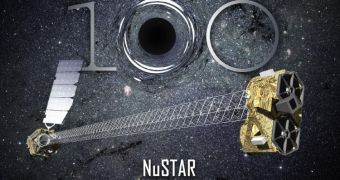The NASA Nuclear Spectroscopic Telescope Array (NuSTAR) telescope successfully completed its 100th day in Earth's orbit today, September 21, after launching into space on June 13, 2012.
The spacecraft was delivered to orbit by a Pegasus-XL rocket, at 1600 GMT. The delivery system itself did not take off from a launch pad, but was delivered to a high altitude by the L-1011 Stargazer aircraft. Both the airplane and the rocket were built by Orbital Sciences Corporation (OSC), in Virginia.
Weighing only 350 kilograms (772 pounds), the spacecraft was injected into a near-Equatorial orbit – of 6-degree inclination – at an altitude of around 550 kilometers (340 miles). From this vantage point, the telescope can survey the Cosmos at X-ray wavelengths.
The thing that makes NuSTAR different from other, similar telescopes is that its focal length can be adjusted, meaning that it is the only observatory of its type that can zoom in or out, depending on the type of view astronomers want.
The purpose of this mission is to conduct in-depth observations on the most energetic phenomena that can occur in the Universe. These include black holes, supernovae, neutron stars, pulsars, magnetars, white dwarf mergers, galactic collisions and so on.
When the telescope reached orbit, it immediately entered a 30-day testing and commissioning phase, which enabled scientists to test the performances of its instruments, and guidance and control systems.
At the same time, mission controllers at the NASA Jet Propulsion Laboratory (JPL) in Pasadena, California, spent a great deal of time trying to understand the dynamics of the 10-meter (33-foot) flexible mast, which is what allows NuSTAR to focus.
“In addition, NuSTAR has continued to team up with other observatories, including NASA's Chandra and Swift telescopes, to make coordinated observations,” the JPL team says in a new statement.
“These joint observations allow astronomers to interpret data from their telescopes more precisely, and to gain a better overall understanding of some of the most extreme events in the Cosmos,” they add.
JPL manages NuSTAR for the NASA Science Mission Directorate, in Washington DC. The mission itself is led by the California Institute of Technology, also in Pasadena, which manages JPL for NASA.

 14 DAY TRIAL //
14 DAY TRIAL //